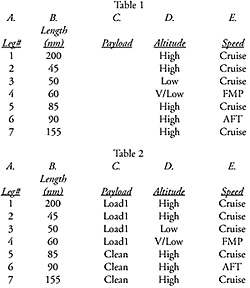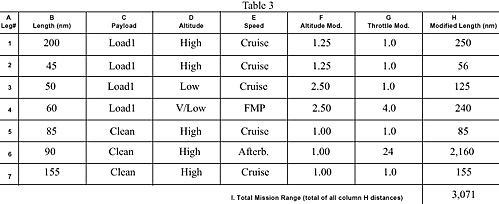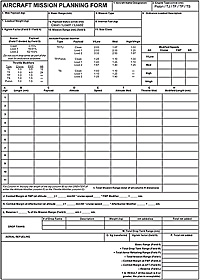I am involved in a large-scale wargame using Harpoon 4 for the naval portion and Tacops from Battlefront.com to simulate the ground battles. Controlling air units, I often find it necessary to do the paperwork and actually work out whether my beautifully planned airstrike can actually reach the target. With that said, I would like to pass on that I have learned about the endurance rules and Harpoon Form 5.
Situation:
Four Tu-22M-5 Backfire have been ordered to destroy a hydroelectric dam. Due to enemy air defenses, it is necessary to approach the target indirectly. The dam is protected by an air search radar with a 100 nm range against large aircraft, of which the Backfire happens to be one. The payload for each Backfire will be 2 FAB-3000M46 bombs, each weighing 2,983 kg.
The route will consist of several legs flown at different altitudes and throttle settings. The first leg is 200 nm long, and since the Backfires are within friendly territory, they will fly at High altitude at Cruise speed.
Following leg #1, the Backfires will begin to turn toward the target. Since they are still outside radar range, the Backfires will remain at High altitude using their cruise speed. They will remain there for 45 nm.
On leg #3, the Backfires drop down to Low altitude to avoid enemy radar, however, they maintain their cruise speed for 50 nm.
The fourth leg is the actual attack. Here the Backfires remain at Low altitude but accelerate to Full Military Power for their attack. This leg is 60 nm long. Following the attack, the Backfires are much lighter and return along leg #5 and head for home. Since they have probably been discovered (dropping 24 metric tons of explosives tends to give you away) the Backfire commander intends to gain altitude and scram. Leg #5 is then flown at High altitude, but still at Cruise speed for 85 nm
Following leg #5, the Backfires will enter the radar envelope of another air search radar. Here, on leg# 6, the commander decides to kick on the afterburner and get through as fast as possible. The leg is 90 nm long and will be flown at High altitude on afterburner.
After that, leg #7 is a leisurely return to base, which is 155 nm away at High altitude and Cruise speed. This will give the crew time to claim bragging rights before touching down. Sounds like a plan, let’s do the math (quit groaning, it is part of the game, too).
Form 5
Reaching into our pile of handy photocopies that every gamer has (am I really the only one?), we take out a Harpoon Form 5 and begin to fill it out.
- Field 1. Aircraft Name/Designation: Tu-22M-5 (Dambuster)
Field 2. Engine Type: Consulting our Data Annex, we see the Backfire is a Turbofan and we circle ‘TF’.
Field 3. Maximum Payload: Again, our handy-dandy Data Annex has the answer and we fill in 24,000 kg.
Field 4. Basic Range: The Backfire has long legs, to the tune of 5,940 nm.
Field 5. Mission Type: Attack, or what would you call the delivery of 24 tons of high explosive?
Field 6. Ordnance Loadout and Description: As we mentioned before, the Loadout is 2 FAB-3000M46’s, each weighing in at 2,983 kg. That goes in the little box.
Field 7. Loadout weight: The total weight is 5,966 kg. In addition, we need to figure out what Loadout class we have. This will modify our endurance. To figure out the class, we divide the Loadout weight (5,966 kg) and divide it by the maximum payload (24,000 kg), giving us 0.2485. We will round to the nearest number and call it 25%. After all, we are not doing accounting here. 25% gives us a Load1, and we circle it on the form next to field 7.
Time to fill in the throttle/altitude information. For the Backfire, it looks like this.:
| Altitude | Speeds | ||
|---|---|---|---|
| Cruise | FMP | Aft | |
| V/Low | 459 | 495 | 594 |
| Med | 459 | 610 | 847 |
| High | 485 | 725 | 1,100 |
| V/High | — | — | — |
So, now time for some number crunching. Reading the rest of the form, it talks about outbound leg and return leg. Wait a minute, what about all those cool turns and so that we planned? We do not just have two legs, we have seven. With that, the usefulness of our original Harpoon Form 5 has ended and it ends up in the bin while we consider collecting stamps. There has to be an easier way. There is. Let me introduce my improved Form 5. It is designed to cover exactly this situation. With it, we can effectively plan up to 11 different legs and the bottom line gives us a no BS statement on whether it will work or not.
Please refer to the blank Form 5 on page 14. If you like, photocopy it and then follow along as I explain how to use it.
We fill out fields 1 to 7, just as we mentioned above. In 7a, we circle the Loadout status, in this case, Load 1, as we determined before.
Field 8, Internal Fuel, we get from the Data Annex. This is 50,000 kg, which is a lot of gas. Field 9, Kg/nm factor, is important for aerial refueling, but that is the subject for another article. It is the Internal Fuel (50,000) divided by the Basic Range (5,940), resulting in a factor of 8.4. Field 10, Mission Range, we will fill out later.
 So, now we can start filling out our legs in the middle of the page. The information looks like Table 1:
So, now we can start filling out our legs in the middle of the page. The information looks like Table 1:
We can fill out the Payload (column C.) with the payload status. On legs 1 to 4, the bombs are still on board, so our payload is Load 1. Legs 5 to 7, the bays are empty, so we have Clean status. Now our table (Table 2) looks like this.
Now, let’s take a look at those factors. Column F is for the altitude loadout modifiers. We find them in the middle of the form.
Now, this is the part where people start saying things like “What the freak is he talking about?” The table in the rule book looks a lot different. That is true, so how did I choose these factors? The easy way. First of all, I am not math genius and fear the day my children ask for help. I find formulas easiest when they have common factors and they are easy to use.
The problem with the formulas in the books is that they work two different ways. In the first (Altitude/Payload modification) modifier, you have to DIVIDE the range by a factor, for example 200 / 0.8. In the second, (Throttle Modifications), have to MULTIPLY by a factor, for example 200 * 4.0.
Now if you change throttle and altitude, it gets confus-ing (ok, it confused me, but I am a math dud), because you are supposed to take the greatest of the factors. Which is greater then, division by 0.8 or multiplication by 4.0? I got my numbers by dividing 1 by the factors listed in the book. Now all the modifiers are of the same type and you ALWAYS multiply by the GREATER of the two modifiers.
 With that said, we can fill out the rest. We will just look at leg one for this (see Table 3).
With that said, we can fill out the rest. We will just look at leg one for this (see Table 3).
We fly 200 nm at High altitude and Cruise speed with Load status One. The Altitude Modifier on Form 5 (Load 1 at High altitude) is 1.25. The throttle modifier, also found Form 5, is 1.0 for a Turbofan aircraft.
Now it is easier to see which factor is greater. 1.25 is greater than 1.0, so the leg distance (in column B) is modified by 1.25 (column F), giving the total range used on the leg (250 nm), which goes in column H. The rest of the mission is laid out in Table 3.
What is missing from the original Form 5 is the ability to stipulate at what altitude we computed the Combat Margin at FMP and Afterburner for. I have added this in field J and K.
For our Backfires, we will figure in 10 minutes at High Altitude with FMP. In addition, we will plan in 3 minutes at High altitude with Afterburner.
J and K then look like this:
- J. Combat Margin at FMP (at altitude High) = 10 min/60 x cruise speed 485 x FMP Modifier 4.0 = 323 nm.
K. Combat Margin at Aft (at altitude High) = 3 min/60 x cruise speed 485 x Aft Modifier 24 = 582 nm.
So, again the cautious aviator stuff. We need a reserve, just in case. We set out reserve to be 15% of the Total Mission Range (field L). This is not the total, unmodified distance of each leg, but rather the total modified distance.
So, 15% of 3,071 nm is 460 nm. Field L then looks like this:
L. Reserve = 15% of the Mission Range (Field K) 3,071 nm = 460 nm.
 If we had drop tanks, we could fill them out in space provided in Field M. I am confident that everyone understands how this works, so we will skip it.
Now, to the totals. We have the following values to total:
If we had drop tanks, we could fill them out in space provided in Field M. I am confident that everyone understands how this works, so we will skip it.
Now, to the totals. We have the following values to total:
Basic Range 5,940 nm
+ Added range for Drop Tanks 0 nm
- Total Mission Range 3,071 nm
- Combat Margin at FMP 323 nm
- Combat Margin at Aft 582 nm
- Reserve 460 nm
Remainder 1,504 nm
This is reflected in Field Q. Since we have a number greater than 0, the plan is OK.
So, that is how I see it. I hope it helps and any comments are certainly welcome.
BT
Back to The Naval Sitrep # 25 Table of Contents
Back to Naval Sitrep List of Issues
Back to MagWeb Master Magazine List
© Copyright 2003 by Larry Bond and Clash of Arms.
This article appears in MagWeb.com (Magazine Web) on the Internet World Wide Web.
Other military history and related articles are available at http://www.magweb.com